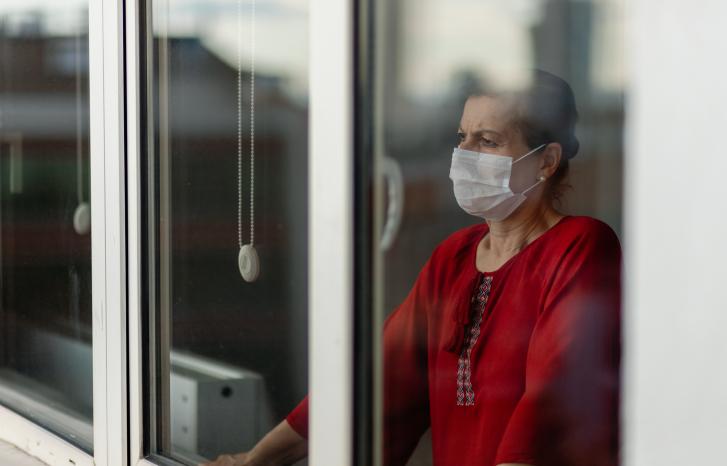“The main conclusion from both studies is that most intimate partner homicides were premonished and with already registered risk factors,” says Solveig Karin Bø Vatnar.
Vatnar is a psychologist with further specialisation at Oslo University Hospital and professor of psychology at Molde University College.
Intimate partner homicides befall various social groups differently.
She was the primary researcher and project leader of the intimate partner homicide study. Together with Christine Friestad and Stål Bjørkly, she has published five articles from the study in international journals in addition to the scientific report ‘Partnerdrap i Norge – endringer over tid?’ (‘Intimate partner homicides in Norway – changes over time?’), which was published last year.
“The most obvious risk factors are previous acts of domestic violence. In seventy-one per cent of the homicide cases, domestic violence has already been registered ahead of the incident.”
Premonished killings
Vatnar was a member of the Intimate partner homicide committee, which submitted their White paper ‘Varslede drap?’ (‘Premonished killings?’) in December 2020. The committee went through the documents from the criminal proceedings of nineteen cases of intimate partner homicides.
Their main objective was to come up with recommendations for measures to prevent intimate partner homicides. The title indicates that there are several risk factors related to intimate partner homicides and that some groups are more exposed than others are.

“Intimate partner homicides befall various social groups differently,” she explains.
“It is still the case that vulnerable groups are more exposed.”
The fact that many of the risk factors occur at the same time, such as violence and other health challenges, substance abuse and other types of crimes, seems to be an important parameter when it comes to intimate partner homicides, according to Vatnar.
“Demonstrating that people who already belong to vulnerable population groups also have a higher risk of experiencing intimate partner homicides is a big challenge,” she says.
“It is therefore important that the findings are used to prevent rather than to stigmatise.”
Prevention may have reduced intimate partner homicides
“What kind of measures might prevent intimate partner homicides?”
“When you make risk assessments, it is important to look at factors relating to the situation, structures and person. Furthermore, all these factors need to be assessed in connection to each other, not just separately,” says Vatnar.
According to her, the risk assessment tool SARA (Spousal Assault Risk Assessment) is useful when assessing the risk of intimate partner violence. This is a tool for the police to assess whether there is any future danger of repeated intimate partner violence in cases where domestic violence has already occurred. Every police district has a SARA coordinator, and the police is legally required to conduct such risk assessments.
One of the findings in the study is that the number of intimate partner homicides fell between 2016 and 2019. The decrease is higher than for other types of homicides.
“This fall might indicate that we have made better use of the potential for prevention over the past years,” says Vatnar.
“I explicitly say might here, since we do not actually know the cause. But the fact that we are seeing a decrease for the first time from approximately 2016, might indicate that we have become better at prevention in cases where there is a risk of intimate partner homicide.”
Within the social sciences, it is generally difficult to establish one or two specific factors as the causes for why things happen. However, researchers may say something about the factors that are normally present when something occurs and whether there is a probability that these factors have been influential. In the present study, the researchers have used statistics to say something about this.
The support system lacks knowledge
Ragnhild Helene Hennum is professor of law and dean of the Faculty of Law at the University of Oslo. She has studied sexualised violence and been head of Partnerdrapsutvalget (The Intimate Partner Homicide Committee). According to her, one challenge in relation to the cases they investigated was that the support system did not always disclose the violence.

“What makes it difficult for the support system to disclose violence?”
“It could be that they do not have sufficient knowledge to realise that what they hear about is in fact violence. Or they do not have the right knowledge about what to do when they are in contact with people who are exposed to violence. Another reason may be lack of training or knowledge about making risk assessments,” says Hennum.
“In several cases, we also observed that they did not use a qualified interpreter. In the health services, for instance, we saw that the assailant was present and acted as an interpreter. Then it becomes impossible for the victim to tell about the violence.”
The White paper states that in some cases there was a congestion of challenges related to living conditions, and the support system would sometimes perceive the violence as less serious.”
“Why do you think this happens?”
“In some cases there are so many problems simultaneously. Other problems become more salient, and the violence winds up in the background,” she explains.
“We do not believe that there have been any ill intentions from the services involved. If the victims of violence have been in considerable contact with the health services and NAV (the Norwegian Labour and Welfare Administration), these support services try to solve the problems belonging to their specific areas of expertise, whereas the other problems wind up in the background.”
“The most important thing for the prevention of violence is to recognise that what is actually going on is in fact violence. The violence must also be given attention as part of the case,” Hennum emphasises.
“The various services need to communicate with each other. The space for sharing information is bigger than what many people realise, but the committee also understands that some of the rules and regulations may not seem easily accessible. We need a set of guidelines that will make it easier for those who apply the rules in their daily work. And this is currently in the making.”
Read also: Sami victims of violence do not seek help
Women also commit intimate partner homicide
Solveig Karin Bø Vatnar and her colleagues’ research indicates that most intimate partner homicides in Norway are committed by a man taking the life of a woman, but the opposite also occurs occasionally. Between 1990 and 2012, eleven per cent of all intimate partner homicides were committed by a woman. Since then, between 2012 and 2019, the number rose to seventeen per cent.
“Are there any differences between men and women who commit intimate partner homicide?”
“There used to be a perception that these were two quite different types of intimate partner homicides, but recent research indicates that they might not be as different as we previously thought.”
It looks as if intimate partner homicides committed by women occur in different types of relationships.
There are nevertheless some distinctions worth noting and looking into, according to Vatnar.
“It looks as if intimate partner homicides committed by women occur in different types of relationships, such as in relationships where the partners have no children together and where there is more substance abuse and other types of crimes,” she explains.
“Intimate partner homicides committed by women thus seem to occur in milieus characterised by more crime than those committed by men. In these groups, it is rarely the case that only one of the partners has a drug problem or is involved with other types of crime. According to our analyses, chances are good both partners have the same or similar problems.”
Gender equality matters
Serious domestic violence and intimate partner homicides are often referred to as gender equality related challenges, as they primarily affect women and constitute a threat to women’s right to live a life free from violence. According to Vatnar, however, it is difficult to maintain that gender equality as a phenomenon can explain the occurrence of intimate partner homicide.
“In an international context, intimate partner homicides are usually connected to female victims. On a global scale, the occurrence of women being killed in close relationships, including intimate partner homicide, is increasing. And the distinctions between areas with high and low incidence rate of female victims of homicide indicate that a lack of gender equality may cause women to become more exposed to homicide and violence in intimate relationships,” she explains.
“But although the UN’s findings point in the direction that gender equality may have significance internationally, it is difficult to determine the significance of gender equality for the national data in Norway.”
“Is that because we have such low numbers when it comes to homicide in Norway in general? Or is it because it is difficult to measure gender equality?”
“It is probably a bit of both. It is difficult to measure the connection between an overriding phenomenon such as gender equality and a phenomenon that occurs less than ten times a year in Norway. Conducting good research on such a connection is very challenging.”
Read also: Domestic violence is a gendered problem
Typical intimate partner homicides receive little media coverage
Typical intimate partner homicides have premonitions, and they occur within marginalised groups. According to Vatnar, this is not covered sufficiently by the media.
“The media create major news reports of the atypical cases,” she says.
“Research on the media coverage of homicides, including intimate partner homicides, demonstrates that the less typical they are, the more attention they receive in the media coverage. The more frequent types of homicides receive less attention in the media. We therefore easily get an incorrect and misrepresented impression of what is typical and atypical when it comes to intimate partner homicides,” she says.
Translated by Cathinka Dahl Hambro.
- In order to be defined as intimate partner homicide, the culprit and the victim must have been in an intimate relationship and lived together.
- One fourth of all homicides committed in Norway are intimate partner homicides. This amounts to an average of eight intimate partner homicides annually.
- The culprit is usually a man, and the victim is usually a woman.
- The National Criminal Investigation Service (Kripos) has not registered any intimate partner homicides among same-sex couples.
- The first study of intimate partner homicides was published in 2015. This study explored homicides committed between 1990 and 2012. Its primary objective was to investigate whether this type of homicides had any common characteristics.
- The most recent study has investigated all intimate partner homicides occurring between 1990 and 2019, a total of 224 homicides. Its main objective was to explore any potential changes since the previous study.
- The researchers have gone through the documents from the criminal proceedings of all intimate partner homicides with a legally enforceable judgement from the period 1990–2019 in order to investigate what characterise the intimate partner homicide process, the context, the situations, culprits and victims.
- A journal article based on the same data material was published in January this year.



